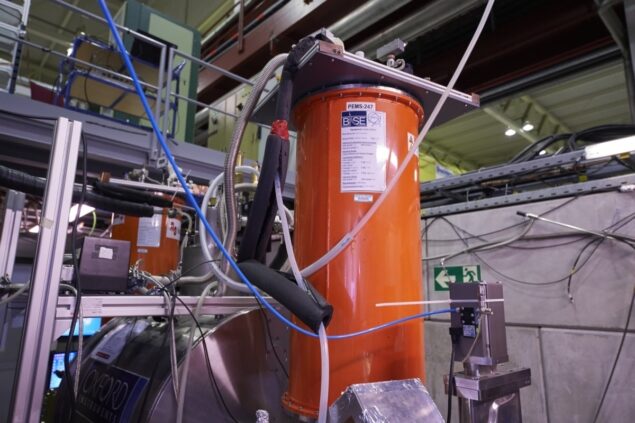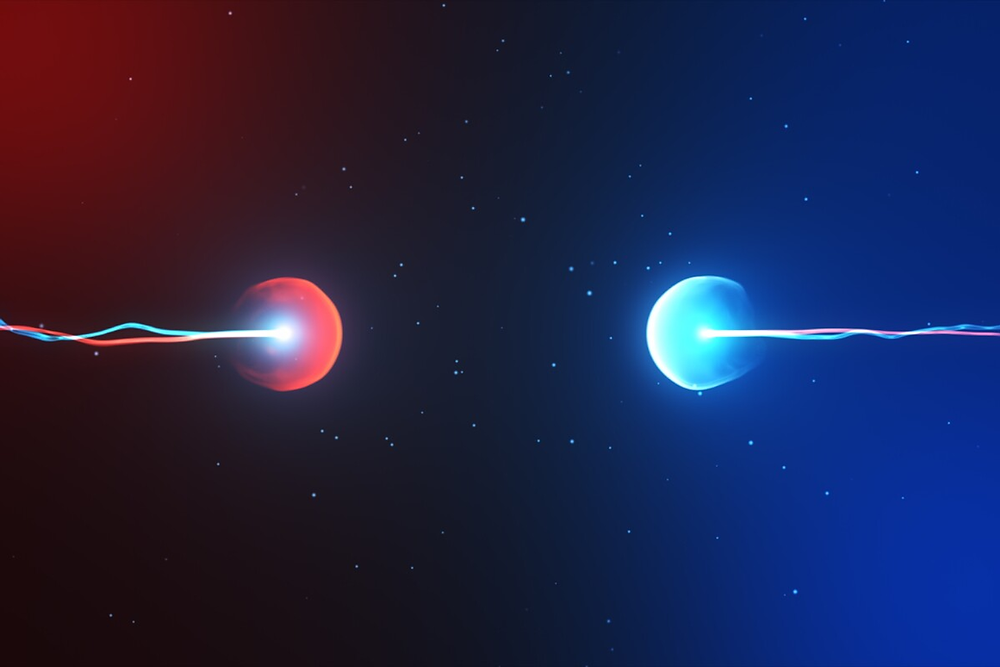Matter is made of baryons and leptons such as protons and electrons. According to the Standard Model, each of these particles has a corresponding antiparticle with identical mass but opposite charge. Just like protons and electrons, these antiparticles can combine to make antimatter. Indeed, physicists at CERN can make antihydrogen by combining an antiproton with an antielectron. These antiprotons are produced in large numbers at CERN in a facility dubbed the "Antimatter Factory".
Enduring mystery
An important and enduring mystery in physics is why the universe appears to be made up almost entirely of matter and contains only tiny amounts of antimatter. The answer to this question could be found by looking for tiny differences between a particle and its antiparticle - which if successful would reveal physics beyond the Standard Model.
The BASE experiment at CERN aims to measure the magnetic moment of the antiproton to very high precision so that it can be compared to the magnetic moment of the proton. This is done using a Penning trap, which holds a negatively charged antiproton using magnetic and electric fields.

The experiment was then repeated using a negatively charged hydrogen ion - which is a proton that is bound to two electrons. This ion was used instead of a positively charged proton so the two measurements could be done under the same experimental conditions - and therefore compared to a very high precision.
Identical results
Measurements were made in four campaigns done between December 2017 and May 2019. In total 24,000 comparisons were made, each lasting 260 s. The BASE physicists found that the charge-to-mass ratios of the antiproton and proton were identical to within 16 parts-per-trillion, which is four times better than previous measurements.
"To reach this precision, we made considerable upgrades to the experiment and carried out the measurements when the antimatter factory was closed down, using our reservoir of antiprotons, which can store antiprotons for years," explains BASE spokesperson Stefan Ulmer, who is based at RIKEN in Japan.
The BASE research backs up the principle that the physics of a system is not affected when its charge, parity and direction of time are flipped. This fundamental symmetry is called CPT invariance, which plays an important role in the Standard Model.
"This result represents the most precise direct test of a fundamental symmetry between matter and antimatter, performed with particles made of three quarks, known as baryons, and their antiparticles," says Ulmer.
Relativistic test
The experiment also tested the weak equivalence principle, which is a consequence of Einstein's theories of relativity. This principle says that the behaviour of an object in a gravitational field is independent of its intrinsic properties - including its mass. A familiar example is that in a vacuum, a feather and a hammer will freefall with the same acceleration.
Earth's orbit around the Sun is elliptical, which means that the gravity experienced at the Penning trap changes slightly over the course of a year. This change affects the cyclotron frequency and the team found that the frequencies of the proton and antiproton changed in the same way. The team therefore confirmed that the weak equivalence principle applies to both antimatter and matter - to a precision of about three parts in 100.
Other experiments at CERN plan to probe the weak equivalence principle by observing antimatter in freefall and Ulmer points out that BASE's result is "comparable to the initial precision goals of experiments that aim to drop antihydrogen in the Earth's gravitational field". "BASE did not directly drop antimatter in the Earth's gravitational field, but our measurement of the influence of gravity on a baryonic antimatter particle is conceptually very similar, indicating no anomalous interaction between antimatter and gravity at the achieved level of uncertainty."
The research is described in Nature.
Hamish Johnston is an online editor of Physics World




Reader Comments
~~
By the way x raised to the power of 2 even if x is infinitesimally small still can never even get close to 0 because that is impossible. Therefore, calculus is flawed at the edges as is just about everything else and foolishness always comes to an end. Pompous fools die the hardest.
~
BK
Still - I look up this Mathis' and decide for myself. I can use all the help I can get and likeminded individuals are needed for this I reckon....assuming our ideas have merit.
Everyone should be aware of Suspicious Observers. They've got a daily quick video on all of this and solar forcing and what not. Ben routinely calls dark matter all sorts of funny things and he really knows what he's doing. [Link] That's their YT page. This is their home page. [Link] (BK, I appreciate and agree with the general propriety of swearing off YT but that won't get around the fact that they've got an illegal monopoly - it will only deprive you of information that can be helpful. We can catch up with the bastards behind all that down the road. )
parzival can better explain why all should keep up with it.
Here's their latest disaster / catastrophe series update: [Link] and here's
today's report - weird, there's not one. (Parz: WTF is up with that? I hope he's OK.) Here's yesterday's. [Link]RC
[Link]
RC
And I didn't even need a bunch of Swiss high-energy swirling imaginary mathematical foolishness to reach this logical conclusion.
Time for heads (not particles - HEADS) to ROLL. Start with the CDC and the FDA and then go from there - public health my ass!
RC
Seth Lloyd, a designer of first quantum computer, said that the universe is a quantum computer, so basically we are living inside a virtual reality running on a computer made of quantum energy. Konrad Zuse also agreed that our universe operates as a computer with a code that makes whatever is possible, possible. Consciousness is the operating system in this cosmic computer which cannot be changed, and our beliefs/feelings are the software that is capable of influencing/changing whatever is being created by the cosmic computer. However, I read some time ago that this universe/cosmic computer has self correcting codes in it, so if someone tries to change something in our reality these self correcting codes will make sure that does not happen. However, you have heard of miracles, well, these happen when someone with their human software does something to override these self correcting codes. This is fascinating stuff.
I am not a smart ass, I just always wanted to understand how this computer simulation is being created. The scientists go into detail with mathematical equations that not even God would understand, like the Hungarian language, but it's not necessary to understand the math behind it because what those equations don't take into consideration is the "soul". The SOUL has a huge part in this game. Without it this virtual reality would collapse, and we all would finally be free. The scientists will never be able to insert the soul into their equations. The CERN as I understand is being used to open doorways into other dimensions and they are also developing technology that will allow the psychos to create a virtual reality within this present one, so basically the next generation of humans will find themselves in a double prison.
The solution to this quandary is for them to add imaginary theories and then go hunting for whatever in hope that it is found.
This means HUGE budgets, endless man hours, all wasted when years later there no further forward and have BUGGER all to show for their efforts.
I personally believe that their hunting for the ultimate force in nature that they can unleash on mankind, as there's absolutely nothing that I've read that suggests otherwise.
Have you seen my theory regarding the non-existence of neutrons?
I'm not kidding. I've laid it all out at my site long-time published, but I know that semantics are a big part of it.
Semantics are not trivial in my humble opinion.
Best to you WN3.
Ken
Regards Winternights3
[Link]
Ken
Ken, I was hopeless at chemistry, I was never good at maths as I'm dyslexia but this doesn't stop me from trying to understand things.
It's strange how some topics register and others do not, seems Chemistry is a weak spot for me but thank you for the opportunity for me to read some of your thoughts on the subject .
RC
All the LHCs create antimatter.
RC
*Deceptively labeled by the PTB as the Mandela Effect. Anyone who thought he had died was simply uninformed and sketchily 'remembering' about Biko or such. Meanwhile, if you wish to witness cognitive dissonance in action, point out that to someone that they supposedly were NEVER labeled as the "Berenstein Bears", etc. and that your friend has erred in their recollection. I've witnessed this before with folks who went back to look at their kids' books, etc. They came back with the ultimate shocked expression on their face and got uncomfortably quiet.
How could ANYONE ever read 'BerenSTAIN and NOT remember it? Especially when the cover of the books has a baby in a diaper! People would have subconsciously thought "BerenSTAIN diapers"? The book never could have been a hit.I don't think so.
I can go on with other examples but shall not.
rc
Not one of all the engineers in my family (all siblings, all but one SIL/BIL, both parents are/were engineers on the space program) have worked for NASA. It's not really talked about but there seems to be a lower level of respect of NASA than for contractor companies. Typical government inanities, etc. Rather, they have worked for contractors. At one point, my Mum was one of only three engineers at a company like Lockheed who were working out there at KSC. (They'd lost the contract, but she had designed the system and the contract winners needed her to run the system because she designed and programmed it. I believe her two other coworkers from there were in a similar situation.)
RC
While I think Douglas Vogt got quite a bit wrong, I his info about government preparations and activities sounds plausible. Think e.g. of the extensive tunnel system ...
I agree re the DMB's etc. They ARE there and a lot more. Many speculate that that was where the moon landing $ and also the 9//10/2001 missing $2.3 trillion. went towards.
RC
And perhaps you remember S0's report about celebrities prepping and building bunkers. There is something going on, and I suspect this is the root cause for the ongoing depopulation plandemic. They want to be all by themselves, a few slaves perhaps.
"In horse race, invariably, one horse wins race."
*
Ben continues Flaying NASA & Dark Matter Scientists....
Have a wonderful day!
BK